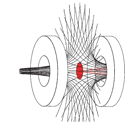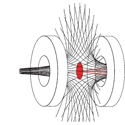Progress toward an antihydrogen beam
Since cold antihydrogen ( ) was created in 2002, the top priority has been to make enough atoms and corral them to measure their spectra. Spectral differences between and would signal a violation of the fundamental CPT (charge-parity-time) symmetry.
An alternative to trapping is to actively extract antihydrogen into a beam that is then sent into a microwave cavity for spectroscopy measurements. This approach also allows the high-precision measurements to be done far from any ill effects of the magnetic fields used to nudge the antiprotons and positrons into binding.
The ASACUSA collaboration at CERN has now taken an important step toward this goal. In a paper appearing in Physical Review Letters, the team demonstrates they can create atoms in an experimental apparatus that could ultimately generate a beam. They used a so-called cusp trap, which consists of a pair of anti-Helmholtz coils (one coil is reversed from the usual Helmholtz configuration) and a series of ring electrodes that surround the coil axis.
After pulses of positrons and antiprotons entered along the axis of their setup, the team mixed them in a “nested trap” within the upstream half of the apparatus. A neutral created there could escape, but if it was created in a highly excited (Rydberg) state and drifted downstream, it would soon become ionized in a stronger electric field, leaving an antiproton that would become trapped.
By opening this second trap and counting the accumulated antiprotons, the team estimated that their system converts between and of incoming antiprotons into antihydrogen in high Rydberg states. They are now working toward creating a spin-polarized antihydrogen beam for high-precision CPT tests. – David Ehrenstein





